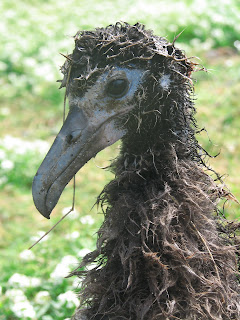
Sunday, March 28, 2010
Odd Birdities

Saturday, March 27, 2010
Rare but Common
Alaska is just straight ahead,
and Antarctica is directly this way.
Bristle-thighed Curlew
Saturday, March 20, 2010
Thursday, March 18, 2010
Monday, March 15, 2010
Wacky weather and a wave that never came
My first week here was very rainy and cold. I practically lived in the only sweatshirt and pair of pants that I brought. There was one day where the winds got up to 50 mph and I could not physically bike to work! It was wild. (I was also excited to mark a 9 on the Beaufort scale for the survey that day - crazy!).
It has lightened up significantly since then and we enjoyed sunny weather all last week. I was happy to finally break out my shorts! Intermittent showers always caught me by surprise though and although I did not have a mirror on hand, I suspect I looked something like this:
 It was probably a Monday.
It was probably a Monday.
As if this wasn't enough to remind me how remote and vulnerable we actually are here on this tiny island in the middle of nowhere, there was also a tsunami scare on the 27th. I think most of the world has heard, but as a result of the massive earthquake in Chile on Feb. 26th, all Pacific Islands received tsunami warnings shortly thereafter. I think Midway had 16 hours of notice to prepare for any damage, which was quite a bit of time, and I was impressed by how calm and organized everyone was. Important equipment and vehicles were driven up to Mt. Bart - the highest point on the island at 34 feet - and we were all ordered to the 3rd floor of Charlie Barracks to wait it out. We were considerably relieved to hear that waves in Hilo, Hawaii only reached around 3 feet and we ended being sent back to our homes after the warning was lifted. Our tsunami wave thankfully never came. Gary's account has pictures.

Call 911! Oh, wait.
Sunday, March 7, 2010
Albatross Chicks

When I first arrived in late February, most were only a couple weeks old and looked like this:

Two weeks later and it looks as though they've swallowed a bowling ball. It takes considerable more effort to stand up so they seem to prefer laying on their big bellies.

This is what I feel like after a good meal at the Clipper House.
This is what I've learned so far: It takes tremendous energy for a mated pair of albatrosses to successfully raise a chick. Breeders will often skip a year to recover and conserve energy. After an egg is laid, both parents take turns incubating the egg for a whopping 65 days! They will feed the chick - sometimes flying incredible distances to forage - for 5 more months until it is ready to fledge. If one of the adults dies during this time, the chick will not survive. Not to worry though - on Midway, the fledging success is an impressive 86%!I look forward to watching them grow. We can compare belly sizes.
Thursday, March 4, 2010
The frizzies

I tried to get the facial expression just right. How'd I do?
Wednesday, March 3, 2010
So, I have a pretty sweet gig here.
 Good, good people
Good, good people
 The Clipper House (dining hall)
The Clipper House (dining hall)- Laysan Albatross
- Bonin Petrel
- Black-footed Albatross
- Magnificent Frigatebird
- Pacific Golden Plover
- White Tern
- Common Canary
- Black Noddy
- Brown Booby
- Common Myna
- Bristle-thighed Curlew
- Laysan Duck
- Short-tailed Albatross
- Red-footed Booby
- Wandering Tattler
- Ruddy Turnstone
- Northern Pintail
- Eurasian Wigeon
- Sooty Tern































